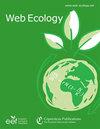为什么有这么多花?葡萄牙入侵长叶金合欢有性繁殖的混合授粉策略初步评估
IF 2.4
3区 环境科学与生态学
Q2 ECOLOGY
引用次数: 5
摘要
摘要长叶合欢(Acacia longgifolia)是一种原产于澳大利亚的豆科植物,已被许多欧洲国家和其他地方引进,成为最重要的全球入侵物种之一。在欧洲,它的花期不适合昆虫活动,尽管如此,它仍被认为是虫栖植物。这个物种的花的特征是令人费解的:明亮的颜色和昆虫喜欢的气味,但有大量的雄蕊,小尺寸的花和相对较小的花粉粒,因为它是普通的嗜风物种。在重塑当地生态网络时,入侵过程尤其受到青睐,因此了解与入侵植物物种相关的授粉综合征可能会促进入侵。此外,其巨大的开花和相对较差的结实率之间存在显著差异。我们引入了一种新颖的方法:首先,我们考虑了部分传粉成功是由风进行的可能性;其次,我们加权了主要传粉者的行为学观点。2016年2月- 4月,我们在龙花开花季节进行了排除实验,检测了昆虫和风的相对贡献。虽然排除实验证实了花粉载体的必要性,但我们实际记录的昆虫丰度很低。蜜蜂,众所周知的金合欢传粉者,相对罕见,并且在成功的访问方面并不总是多产的。虽然风有助于种子的形成,但焦点观察证实,蜜蜂在访问花序收集花粉和访问花外蜜腺收集花蜜时传递花粉。这种混合授粉策略可能是它成功入侵葡萄牙多风海岸的基础。本文章由计算机程序翻译,如有差异,请以英文原文为准。
Why so many flowers? A preliminary assessment of mixed pollination strategy enhancing sexual reproduction of the invasive Acacia longifolia in Portugal
Abstract. Acacia longifolia, a native legume from Australia, has been
introduced in many European countries and elsewhere, thus becoming one of the
most important global invasive species. In Europe, its flowering occurs in a
period unsuitable for insect activity: nonetheless it is considered
entomophilous. Floral traits of this species are puzzling: brightly coloured
and scented as liked by insects, but with abundant staminate
small-sized flowers and relatively small pollen grains, as it is common in
anemophilous species. Invasion processes are especially favoured when
reshaping local ecological networks, thus the interest in understanding
pollination syndromes associated with invasive plant species that may
facilitate invasiveness. Moreover, a striking difference exists between its
massive flowering and relatively poor seed set. We introduced a novel
approach: first, we consider the possibility that a part of the pollination
success is carried on by wind and, second, we weighted the ethological
perspective of the main pollinator. During the flowering season of A. longifolia (February–April 2016), we carried on exclusion experiments to
detect the relative contribution of insects and wind. While the exclusion
experiments corroborated the need for pollen vectors, we actually recorded a
low abundance of insects. The honeybee, known pollinator of acacias, was
relatively rare and not always productive in terms of successful visits. While wind
contributed to seed set, focal observations confirmed that honeybees transfer pollen when visiting both the inflorescences to collect pollen and
the extrafloral nectaries to collect nectar. The mixed pollination strategy
of A. longifolia may then be the basis of its success in invading
Portugal's windy coasts.
求助全文
通过发布文献求助,成功后即可免费获取论文全文。
去求助
来源期刊

Web Ecology
Agricultural and Biological Sciences-Ecology, Evolution, Behavior and Systematics
CiteScore
4.60
自引率
0.00%
发文量
6
审稿时长
17 weeks
期刊介绍:
Web Ecology (WE) is an open-access journal issued by the European Ecological Federation (EEF) representing the ecological societies within Europe and associated members. Its special value is to serve as a publication forum for national ecological societies that do not maintain their own society journal. Web Ecology publishes papers from all fields of ecology without any geographic restriction. It is a forum to communicate results of experimental, theoretical, and descriptive studies of general interest to an international audience. Original contributions, short communications, and reviews on ecological research on all kinds of organisms and ecosystems are welcome as well as papers that express emerging ideas and concepts with a sound scientific background.
 求助内容:
求助内容: 应助结果提醒方式:
应助结果提醒方式:


